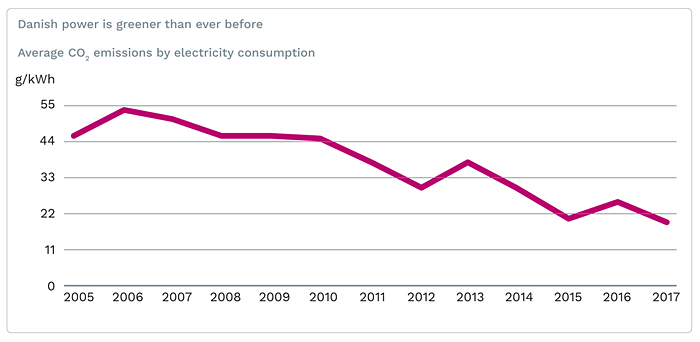Denmark has set itself on a path towards 55% renewable energy in 2030 and net zero emissions by 2050 at the latest in a new Energy Agreement adopted with support of all parties in the Danish Parliament.
 The new Danish energy agreement contains a wide range of ambitious green initiatives and lowering of electricity taxes. It will help Danish consumers replace fossil energy with green electricity. Companies and consumers will receive greener heating through a modernisation of the heating sector.
The new Danish energy agreement contains a wide range of ambitious green initiatives and lowering of electricity taxes. It will help Danish consumers replace fossil energy with green electricity. Companies and consumers will receive greener heating through a modernisation of the heating sector.
The new energy agreement sets a clear direction for turning Denmark into a net zero emissions society by 2050 at the latest - meaning that there will be a balance between the amount of greenhouse gas emitted and removed from the atmosphere. The first step will be to supply up to 55% of the Danish energy consumption with renewable energy by 2030. To achieve this while keeping electricity bills down, Denmark will introduce more competition to the renewable energy sector and build large offshore wind farms which are to set a blueprint for offshore wind energy without public subsidies. Denmark will overhaul taxes on energy that will deliver a green transition of the energy sector at a
lower cost.
The majority of these initiatives are to be realised from 2020 to 2024. From 2025 onwards, substantial additional funding will be allocated to a reserve for further deployment of renewable energy. Given the uncertain nature of technology and price developments between now and 2030, Denmark will assess its efforts on a regular basis to ensure that the renewable energy goal for 2030 is reached at the lowest possible cost.
With this energy agreement, three new offshore wind farms will be established by 2030. The first wind farm will consist of 800 MW. Once completed, it will be the largest of its kind in Denmark. It will be constructed in the period 2024-2027. Efforts to realise energy savings will be largely focused on gaining greater value for money and thereby addressing criticism of the existing system. Energy and climate research gets a cash injection with the goal of allocating DKK1 billion a year in 2024. At the same time, there will be substantial lowering and restructuring of energy taxes as well as a smarter use of waste heat.

THE AGREEMENT UNDERPINS DENMARK'S POSITION AS ENERGY AND CLIMATE LEADER
Danish Minister of Energy, Utilities and Climate, Lars Christian Lilleholt is very pleased with the final agreement.
"The government's long-term goal is for Denmark to become a net zero emissions society by 2050 at the latest. This means that the amount of greenhouse gas emitted will equal the amount removed from the atmosphere. I am therefore pleased and proud that all the parties in the Danish parliament have united behind this agreement which underpins Denmark's position as an energy and climate pioneer. It creates confidence and secures consistency that this is the direction we are heading towards," says Lars Christian Lilleholt.
The new Danish energy agreement includes the following initiatives:
- A commitment to work towards a target of net zero emissions by latest 2050 for both Denmark and the EU.
- By 2030, three offshore wind farms will be established, without public subsidies except for the transmission, with a total of at least 2400 MW. It is expected that the wind farms due to technology developments will be significantly cheaper to construct than wind farms of the past.
- DKK4.2 billion (€564 million) is allocated to a tender process, where different technologies such as onshore wind and solar can compete on delivering green electricity at the lowest price.
- More than DKK4 billion (€537 million) is allocated to expand the production of biogas and other green gasses. A share is allocated for organic biogas.
- From 2021 to 2024, DKK500 million (€67 million) annually will be allocated to a market-based grant pool focused on energy savings - primarily in business - DKK300 million (€40 million) for industries and DKK200 million (€27 million) for energy savings in buildings.
- A reserve of DKK400 million in 2025 (€54 million) and then DKK500 million (€67 million) annually will be allocated to further enhancing the use of renewable energy after 2026.
- Immediate lowering of electricity and electric heating taxes amounting to approximately DKK2 billion (€268 million) in 2025 (excl. VAT).
- A modernisation of the heating sector where both the district heating sector and consumers have a free choice to decide future investments, resulting in greener heating for both companies and consumers.
- Phasing out coal in the Danish electricity production by 2030
- Energy and climate research will receive a cash injection with a target of DKK1 billion (€134 million) by 2024
- DKK500 million (€67 million) is allocated to green transportation in 2020-2024 to enhance green mobility and transportation.
- Working towards ambitious CO2 standards for cars, vans and heavy duty vehicles.